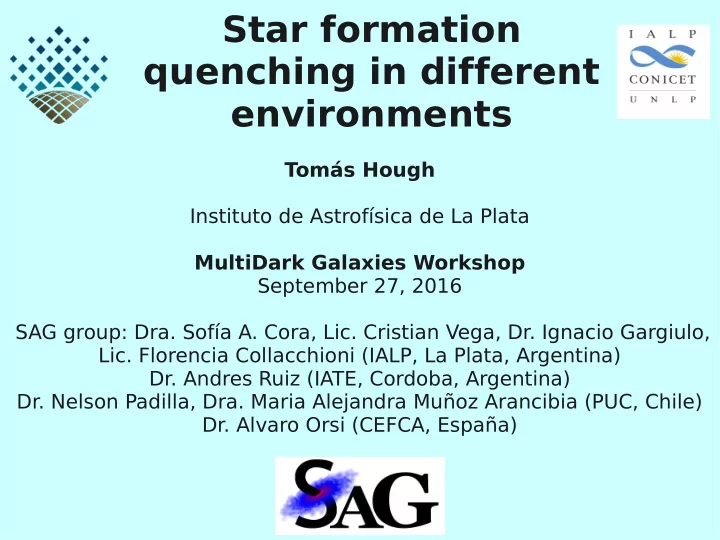

Star formation quenching in different environments Tomás Hough Instituto de Astrofísica de La Plata MultiDark Galaxies Workshop September 27, 2016 SAG group: Dra. Sofía A. Cora, Lic. Cristian Vega, Dr. Ignacio Gargiulo, Lic. Florencia Collacchioni (IALP, La Plata, Argentina) Dr. Andres Ruiz (IATE, Cordoba, Argentina) Dr. Nelson Padilla, Dra. Maria Alejandra Muñoz Arancibia (PUC, Chile) Dr. Alvaro Orsi (CEFCA, España)
Galaxies in high density environments (cores of rich clusters) Lower star Redder colors Bulge- formation rates dominated morphologies
First studies Butcher & Oemler (1984) reported an increase in the fraction of blue galaxies in 33 rich galaxy clusters out to z ∼ 0.5 compared to local clusters. Butcher&Oemler (1984)
New studies → many complexities Star formation vs Star formation vs halo mass stellar mass ● Higher stellar mass → higher ● Higher halo mass → higher fraction of quiescent galaxies fraction of quiescent galaxies (Wetzel et al 2013), lower (Wetzel et al 2013) fraction of blue galaxies (Raichoor et al 2012) ● Lower halo mass → lower ● Lower stellar mass → lower fraction of quiescent galaxies fraction of quiescent galaxies (Wetzel et al 2013) (Wetzel et al 2013), higher fraction of blue galaxies (Raichoor et al 2012). Increase in the fraction of star-forming galaxies with cluster-centric distance (Weinmann+06, Haines+09, Raichoor & Andreon+12).
New studies → many complexities Raichoor&Andreon(2012) 25 X-Ray selected clusters
New studies → many complexities Wetzel et al (2012) SDSS DR7 sample. z∼0.045 M star >5 x 10⁹
New studies → many complexities Wetzel et al (2012) SDSS DR7 sample. z∼0.045 M star >5 x 10⁹ R/R200
Environmental effects Physical processes that affect galaxy evolution by removing galaxy's gaseous components:
Environmental effects Physical processes that affect galaxy evolution by removing galaxy's gaseous components: ● Tidal interactions ● Harassment ● Starvation ● Ram-pressure stripping
Environmental effects Physical processes that affect galaxy evolution by removing galaxy's gaseous components: ● Tidal interactions ● Harassment ● Starvation ● Ram-pressure stripping
Discusion: SF quenching Which is the On which predominant timescales is physical produced? process? Where is the SF quenching triggered?
Discusion: SF quenching Which is the On which predominant timescales is physical produced? process? Where is the SF quenching triggered?
Timescales ● Starvation: t q > 6 Gyr, for Herschel Reference Survey galaxies (Bosseli et al 2014), supported by numerical simulations (McGee et al 2014) ● Galaxy-galaxy interactions: t q > 3 – 6 Gyr (based on typical timescales, Mastropietro et al 2005) ● Ram-pressure stripping: t q < 1 Gyr (Roediger & Hensler 2005, McCarthy et al 2008)
Timescales ● Starvation: t q > 6 Gyr, for Herschel Reference Survey galaxies (Bosseli et al 2014), supported by numerical simulations (McGee et al 2014) ● Galaxy-galaxy interactions: t q > 3 – 6 Gyr (based on typical timescales, Mastropietro et al 2005) ● Ram-pressure stripping: t q < 1 Gyr (Roediger & Hensler 2005, McCarthy et al 2008) McCarthy et al (2008)
Onset of quenching ● Gas stripping can occur outside viral radius: ∼5 x r200 (Bahé et al 2013, 2014) ● Gas stripping starts when a galaxy is accreted (Wetzel et al 2013) ● RPS takes 50% gas content when r500 < r < r200 in 0.5 – 1 Gyr (Roediger & Hensler 2005, HDS) ● RPS is effective as far out as r500 (Merluzzi et al. 2013).
Pre-prossesing ● Quenching timescales and location can account for which mecanism dominates galaxy quenching in high density environments.
Pre-prossesing ● Quenching timescales and location can account for which mecanism dominates galaxy quenching in high density environments. But its not that simple! log(M halo /M ⊙ )∼14-15 → the dominant mode of infall is as a satellite in a lower mass halo →pre-prossesing (Wetzel et al 2013).
Pre-prossesing ● “Slow-then-rapid quenching”: some mechanism acts in galaxy groups → group is accreted → rapid quenching. Haines et al (2015)
Pre-prossesing ● “Slow-then-rapid quenching”: some mechanism acts in galaxy groups → group is accreted → rapid quenching. Haines et al (2015)
Current Work MultiDark Simulation + SAG Evolution of the fraction of quiescent galaxies: ● Central + satelite galaxies (within R 200 ) ● M halo ● M star ● 8 calibration boxes, vol=111.188³ (Mpc/h)³ ● Tidal stripping + RPS on hot gas halo McCarthy et al (2008)
Current Work MultiDark Simulation + SAG z=0.39
Current Work MultiDark Simulation + SAG z=0.14
Current Work MultiDark Simulation + SAG z=0
Current Work MultiDark Simulation + SAG Preliminary results Quiescent fraction: dependence on halo mass
Current Work MultiDark Simulation + SAG z Wetzel (2013) Quiescent fraction: dependence on stellar mass
New studies → many complexities Wetzel et al (2013) SDSS DR7 sample (z∼0) M star >5 x 10⁹ + Cosmic Evolution Survey (Drory et al 2009). z
Current Work MultiDark Simulation + SAG Wetzel (2013) z Preliminary results Quiescent fraction: dependence on stellar mass
Future Work ● Analize central and satelite quenching separatedly (Wetzel et al 2012, 2013; Bluck et al 2016) ● Explore different SF classification criteria (Weinmann et al 2006) ● Analize SF activity of galaxies to be accreted and the environment in which they reside (pre- prossesing).
THANK YOU!
Recommend
More recommend